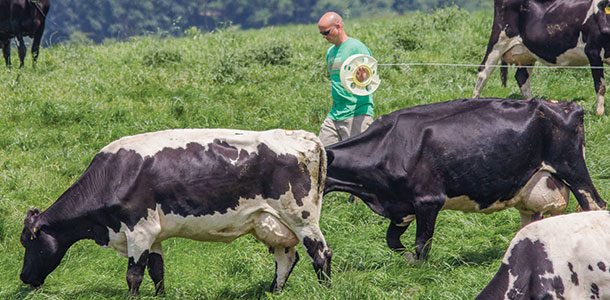Rotational grazing, or the practice of rotating livestock through several smaller pastures instead of housing them in one large pasture, is nothing new; however, it has been gaining more momentum recently.Like many ideas, it has its fair share of skeptics and staunch supporters. Originally, a system such as this would have been difficult to set up due to the additional fence and water access requirements.
Today, however, electric fencing and temporary water systems have eased much of that constraint, making rotational grazing a more feasible option.
According to Dr. Ray Smith, extension forage specialist at the University of Kentucky, the design of the rotational grazing system is to better manage plant growth. If left alone, livestock will almost always graze only from certain areas of the pasture and defecate on other parts.
The result is that part of the pasture is grazed to the dirt while the other half is wasted because most livestock will not eat forages after they have contaminated them.
The producer is then presented with a dilemma: leave the livestock there and supplement feed until the forages grow back or move the animals to a different pasture.
Rotational grazing eliminates this problem. Since the pasture is divided into several small paddocks, livestock are forced to eat from every area of the paddock instead of just their favorite areas. This causes more even grazing and a better distribution of the nutrient-rich manure.
Additionally, by moving livestock more frequently, forages can be grazed to a more appropriate length, enabling the plant to grow back instead of having to re-plant it. This is the key to the rotational grazing system. To better understand how to manage plant growth, one must understand plant growth.
Managing plant growth
The level of defoliation, or the amount of foliage left after the forage has been grazed, is a major factor in determining a plant’s ability for regrowth. Energy is required for the plant to grow back. It will get the energy from the remaining leaf area, stored carbohydrates and either the base of the plant (if it’s a grass) or the roots (if it’s a tap-rooted legume).
The leaf is where photosynthesis occurs, which is the process by which the plant produces additional carbohydrates. Without these resources, the plant will have a much more difficult time growing back or may not be able to grow back.
Another concern related to close grazing is its effect on root growth. By repeatedly depriving the plant of its stored carbohydrates, the plant is forced to put all of its efforts into regrowth so it can replenish those stores before it is grazed again. The biggest downfall of this is: It takes away from the growth of the plant’s root system.
A deep root system can increase the plant’s access to water and nutrients, which greatly increases its drought tolerance. A plant subjected to close continuous grazing will likely have a stunted root system, and regrowth will be slower.
However, a good root system enables it to re-grow faster and for a longer duration throughout the year, increasing the amount of time livestock can graze.
Tap-rooted legumes, such as alfalfa and red clover, are a little different than grasses in terms of regrowth. They are entirely dependent on the carbohydrates stored in the root system. Alfalfa can be grazed once it has reached late bud to early bloom stage and has replenished its root reserves.
Once it’s ready to be cut or grazed, only about 2 inches of stubble height need to be left. It will need a 30-day to 35-day rest period to allow for the cycle to complete itself again. Red clover and most other legumes follow a similar pattern.
With the exception of white clover, which can tolerate more continuous grazing, most legumes need this cycle of grazing and rest in order to grow close to or at maximum potential. Not allowing this cycle to occur can lead to stand loss and reduced regrowth.
According to Smith, maximum regrowth, persistence and quality are the three goals of rotational grazing. A basic knowledge of the forages being grown is necessary to accomplish this.
Since legumes store their carbohydrates in the root system, they can tolerate a lower cutting or grazing. Ideally, this will be around 2 to 3 inches. Most grasses, on the other hand, will generally prefer a higher cutting height of about 3 or 4 inches, allowing extra leaf area to store and produce carbohydrates for regrowth.
Consequently, higher cutting heights will favor the grass while lower cutting heights will favor the legume. The general rule of thumb, however, is to favor the legume when planting and maintaining pastures with mixed forages. These “rules of thumb” are especially important for cool-season forages.
Factors affecting pasture management
A variety of factors will affect a rotational grazing operation, including the end product for the animals and the farm’s location. Some operations will move animals one time or multiple times a day.
This would be more practical for grass-fed dairy or beef operations where a large supply of highly nutrient-rich food is required since the animals are receiving limited concentrate or grain.
Many operations use a more lenient rotation system and move animals every four to seven days. Whether animals are rotated every day or every week, it is essential to allow an adequate rest period before returning to the same pasture.
Rest periods range with different forages, but a good rule of thumb is a four-week rest period. However, it may be shorter in the spring or longer during slow growth periods like summer.
Additionally, Smith points out that operations on the East Coast will look vastly different than those on the West Coast. This variation is based on rainfall, soil quality and forage type.
Many of the Western states graze on rangeland, where native grasses are the predominant forage. Their biggest advantage from rotational grazing will be more even grazing of their pastures and better management of the high-quality native grasses, which can be sensitive to overgrazing.
The West can be more challenging for rotational grazing systems than the East, where 2 acres per mature cow in a cow-calf operation is often feasible. In the West, an operation might have a ratio or 20, 30 or even 50 acres per mature cow.
As a result, the amount of land needing to be covered by fence and additional water systems can present an added challenge not experienced by Eastern counterparts.
Not to say ranchers in the West shouldn’t consider this method of pasture management, but rather that a system with a few larger pastures where the animals are moved once a week or once every few weeks might be preferable over a smaller and more concentrated grazing system where animals are rotated multiple times a week.
Unforeseen benefits
Although rotational grazing might seem like more work since animals are moved more frequently, Smith says many farmers actually found it was less work throughout the year and a more pleasant system to use. Because the pastures were given a rest periodically, the plants grew longer through the summer and lasted further into the winter, decreasing the amount of time farmers spent feeding hay or other forages.
Additionally, animals were more familiar with people, making them more pleasant to work around and easier to handle. Diseased or injured animals were also caught sooner, which helped to increase overall herd health.
Just because one system works for one producer doesn’t mean it will work for everyone. Producers can learn from each other, but they also know what will and what won’t work on their operation.
The point is to start small. Make changes over time rather than all at once. Start by dividing the pasture in half and see how that works. If it does, divide those two in half again and go from there. It isn’t something that will completely change overnight; rather, give it time – time for learning and time for the system to develop. FG
The information in this article is taken from Dr. Ray Smith’s presentation entitled “Forage Growth and Relationship to Management” and a subsequent interview at the Pennsylvania Forage Grower Council’s tour in June 2014. Dr. Smith is an extension forage specialist at the University of Kentucky.
PHOTO
Matt Beiler uses a rotational grazing system for his dairy herd in Paradise, Pennsylvania. Rotational grazing prevents cows from picking and choosing only favorite forages, and provides more even manure distribution. Photo by Jenna Hurty.










